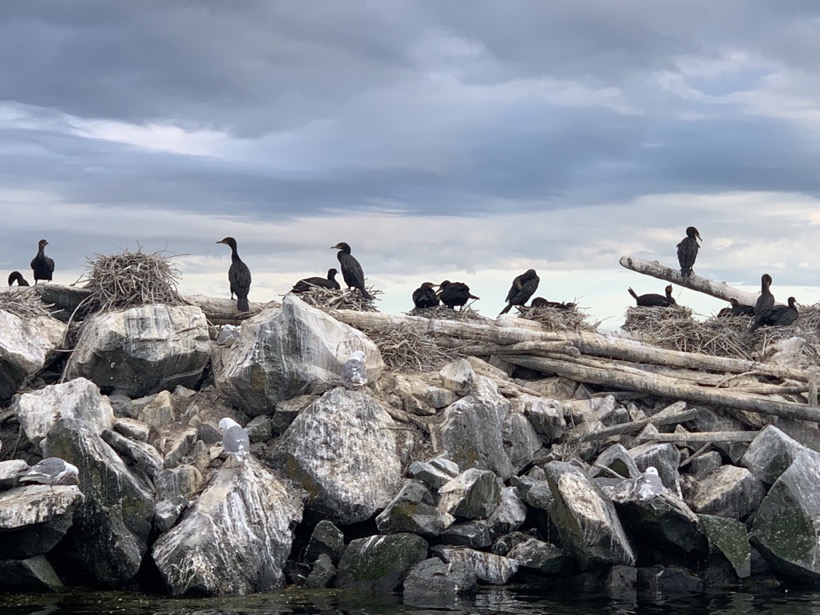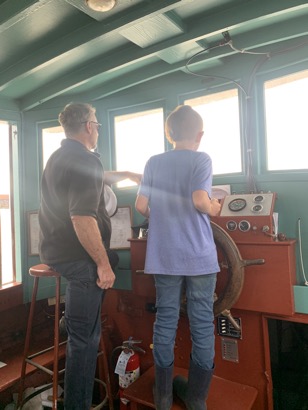Touring the harbor
27/08/22 01:03

Drayton Harbor at Blaine is a large bay that is nearly fully enclosed by a natural spit of land that extends along one side of the harbor, leaving just a narrow entrance. It is a natural safe harbor. There are marinas at the town of Blaine and at the end of the Semiahmoo Spit. In years past there were canneries at the end of the spit. The canneries are no longer in operation and the area where they were located is now a resort with a large hotel and high end condos. Where the spit joins the mainland there is a golf course surrounded by fancy homes. Back in the days when the canneries were in operation, there was a passenger ferry that carried workers from their homes in Blaine to the canneries and back at the end of the work day. That ferry now is a tourist attraction, running back and forth on weekends during the summer. In the late afternoon yesterday, we took three of our grandchildren for a round trip from Blaine over to Semiahmoo and back on the Plover Ferry. It was a calm day and we had a fun ride. We got a tour of the marina with all of the fancy yachts and fishing vessels and a brief tour around Drayton Harbor along the way. The children got to have a turn at the wheel next to Captain Ron. There were a lot of harbor seals sunning themselves on the floating docks marking the Semiahmoo marina and a large rookery where seagulls and cormorants have their nests.
The harbor is rich with sea life. There is a large commercial oyster farm at one end of the harbor. Folks can catch crabs off of the public pier in Blaine. Others with access to boats fish alongside commercial crabbers and fishers inside and outside the harbor.
People aren’t the only ones who are successful with the fishing. Brandt’s Cormorants can dive as deep as 200 feet and forage for both swimming fish and shellfish on the bottom of the harbor. Unlike the gulls which are constantly crying and fighting over the fish they find, the cormorants are nearly silent, making only a few soft sounds when they are on their nests. Summer is drawing to a close and the hatchlings are nearly as large as their parents.

The Salish Sea with all of its islands, inlets, bays and natural harbors has provided food for birds, sea mammals and humans from time immemorial. The development and increase in human population in the last 200 years has created pressures on birds and other animals of the sea. There is a lot to learn about this place and the creatures that call it home. Along with a desire to paddle the inland waters and observe more of the life of the birds and other creatures, I am planning a visit to the Marine Life Center in Bellingham and a couple of other places engaged in studying coastal creatures.
I can’t help but think of the famous line from the Wizard of Oz: “Toto, I don’t believe we are in Kansas anymore.” We never lived in Kansas, but having spent most of our carers in the Dakotas and all of our life up until our retirement a thousand miles from the ocean, we have found ourselves in a new life and are fascinated by all of the differences between this place and the place we used to call home.
Things have not yet returned to normal as the pandemic moves into its third year, but more tourist venues, including the Plover Ferry, are finding ways to invite guests to our community. Birch Bay and Blaine are heavily dependent on the tourists who come to enjoy the sea and play in the gentle waters. Those of us who are fortunate to live here year round notice the crush of all of the visitors. Although the numbers aren’t up to pre-pandemic levels, there are a lot more people in our quiet little villages than was the case during our first autumn and winter here. There are times when it is difficult to find a parking space among all of the cars from British Columbia. For the residents of metro Vancouver, we are a place where they can escape the urban environment and enjoy the natural world. Unlike the Black Hills, where there is also a vibrant tourist economy, most of our guests come from a single Canadian province. We used to play a game with our kids to see how many of the states and provinces we could find on the license plates in the parking garage at Mount Rushmore. We wouldn’t be as successful with the variety here, but the percentage of out of state cars is about the same. Living right on the border means that British Columbia plates are nearly as common as Washington plates on the cars parked along the bay.
One of the fun things about living in a place where tourists visit is that we can answer their questions about the place where we live. However, we are newcomers to this area and sometimes are as uninformed as the other tourists. We have to ask the names of the birds we see and learn the stories of the places we visit. Slowly, however, we will become more like the natives. Yesterday on the ferry I was already answering a few questions about what it is like to live in this place. Give me a few years and I’ll know even more.
